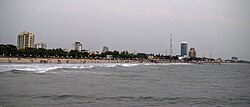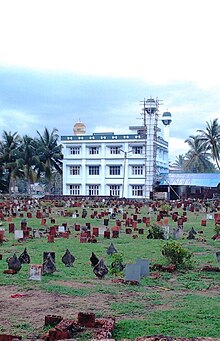Kozhikode Beach: Difference between revisions
History of Kozhikode |
remove off-topic material copied from Kozhikode |
||
| Line 39: | Line 39: | ||
==History== |
==History== |
||
100 years ago Valiyangadi and the beach area were the centre of Kozhikode city. In the 1970s the downtown shifted to [[Mananchira]] area and again, in the 1980s, [[Mavoor Road]] became the centre of attraction. In 2010s, [[Thondayad Junction|Thondayad]] Bypass area and [[Palazhi]] on the [[Calicut Airport|Airport]] road has emerged as the new city centre with a vibrant night life. |
|||
[[Kozhikode]]<ref>{{Cite web|url=https://kozhikode.nic.in/about-district/history/|title=Kozhikode|last=|first=|date=|website=Encyclopaedia of Islam, THREE|archive-url=|archive-date=|dead-url=|access-date=2019-08-02}}</ref> also known as Calicut, is a city in the state of Kerala in southern India on the Malabar coast. Kozhikode is the largest urban area in the state and 195th largest urban area in the world. During classical antiquity and the Middle Ages, Kozhikode was dubbed the “City of Spices” for its role as the major trading point of Eastern spices. It was the capital of an independent kingdom ruled by the Samoothiris(Zamorins) in the Middle Ages and later the capital of the erstwhile Malabar district under British rule. Arab merchants traded with the region as early as 7th century, and Portuguese explorer Vasco da Gama dropped anchor at Kozhikode on 20 May 1498, thus opening a trade route between Europe and Malabar. A Portuguese factory and fort functioned in Kozhikode for a short period (1511–1525, until the Fall of Calicut). The English landed in 1615 (constructing a trading post in 1665), followed by the French (1698) and the Dutch (1752). In 1765, Mysore captured Kozhikode as part of its occupation of the Malabar Coast. |
|||
While the city has been known in history under different names, Malayalam speaking communities have traditionally called it Kozhikode. Arab merchants called it Qāliqūṭ. Tamils called it Kallikkottai while for the Chinese it was Kalifo. Although the city’s official name is Kozhikode, in English it is sometimes known by its anglicised version, Calicut. The word calico, a fine variety of hand-woven cotton cloth that was exported from the port of Kozhikode, is thought to have been derived from Calicut. |
|||
Kozhikode is a town with a long recorded history. From time immemorial, the city has attracted travellers with its prosperity. It has traded in spices like black pepper and cardamom with Jews, Arabs, Phoenicians, and Chinese for more than 500 years. As Kozhikode offered full freedom and security, the Arab and the Chinese merchants preferred it to all other ports. Kozhikode was the capital of Malabar during the time of Sri Samoothiri Maharajas, who ruled the region before the British took over. The city’s first recorded contact with Europe was when Vasco da Gama docked at Kappad (18 km north) in May 1498, among the leaders of a trade mission from Portugal. He was received by Sri Samoothiri Maharaja himself. Kozhikode and its suburbs formed part of the Polanad kingdom ruled by the Porlatiri. The Eradis of Nediyirippu in Eranad wanted an outlet to the sea, to initiate trade and commerce with the distant lands and after fighting with the king Polatthiri for 48 years conquered the area around Panniyankara. |
|||
On 7 June 2012, Kozhikode was given the tag of “City of Sculptures”(Shilpa Nagaram) because of the various architectural sculptures located in various parts of the city. |
|||
==Important landmarks== |
==Important landmarks== |
||
| Line 92: | Line 86: | ||
==See also== |
==See also== |
||
* [[Kozhikode]] city |
|||
* [[Kozhikode North]] |
* [[Kozhikode North]] |
||
* [[Kozhikode South]] |
* [[Kozhikode South]] |
||
Revision as of 15:58, 3 August 2019
This article needs additional citations for verification. (March 2016) |
Kozhikode Beach | |
|---|---|
 Kozhikode Beach | |
| Coordinates: 11°15′22″N 75°46′10″E / 11.25607°N 75.76940°E | |
| Country | India |
| State | Kerala |

Kozhikode Beach or Calicut Beach is a beach on the western side of Kozhikode, situated on the Malabar Coast of India. The beach is accessible through four road overbridges in the city. The beach has paved stones and illumination. There is one Lions Park for the children and an aquarium. Kozhikode beach has always been a prominent place for conducting public meetings. The beach road was renamed 'Gandhi Road' in 1934 after Gandhi visited Calicut in 1934.
History
100 years ago Valiyangadi and the beach area were the centre of Kozhikode city. In the 1970s the downtown shifted to Mananchira area and again, in the 1980s, Mavoor Road became the centre of attraction. In 2010s, Thondayad Bypass area and Palazhi on the Airport road has emerged as the new city centre with a vibrant night life.
Important landmarks

- Barami Masjidh
- Santhwanam NGO, Cherootty Road
- Gandhi Peace Foundation, Cherootty Road
- All India Radio, Beach Road
- Corporation Office, Beach
- Thodiyil Shree Bhagawathy Temple
- Gurajathi School, Gujarathi Street
- St.Josephs Boys School
- District Court, Kozhikode
The 28-km beach road
Kozhikode Beach has a long drive from Beypore in the south to Kappad in the north. The following beaches are part of Kozhikode Beach:
- Beypore, Payyanakkal and Marad
- Kallayi, Kuttichira and Thekkeppuram
- Vellayil, South Beach and Valiyangadi
- Kamburam, Putiyappa and Elathur
Valiyangadi
On the southern side of the beach, Valiyangadi was the place where European and Arab traders brushed shoulders just a few centuries back. There is one Gujarathi Street and a Halwa Street on the locality. Francis Road, Halwa Road and Thangal Road form a triangle here leading to the Bavutty Haji Road on the beach. The dargah called 'Sheikh Makham' is a center of Sunni Pilgrimage here. The road towards the south reaches the Chakkum Kadavu bridge and has access to the Kallayi, Marad and Beypore beaches.
Mishkal Masjidh
The Mishkal Masjidh is a four storied mosque at Kuttichira in Kozhikode city. The mosque is about 700 years old. Originally built of wood in five stories, the mosque was later rebuilt into the present four stories. The mosque has 47 doors, 24 pillars decorated with carvings and a very big prayer hall that can accommodate 400 people. [1]
Cherootty Road
The Road over bridge from Mananchira to the Kozhikode beach takes you to the Red Cross Road that terminates in the beach. Cherootty road is one of the offshoots of the Red Cross Road that ends at Court Road near the Mathrubhumi newspaper office. This is a major shopping area of the Kozhikode beach area with many branded clothing shops and branches of nationalized branches on either side of the road. Gandhi Peace Foundation is maintaining an office there. The convent road is a branch of the Cherootty Road. Tagore Centenary Hall, Muslim League Office, Moonnalingal junction and the Beach Office are also connected to the Red Cross Road. The Silk Street and the Court Road runs parallel to Cherootty Road. The Silk Street has a Punjabi school, St.Joseph’s school and Sidhi Durbar. Further west of the Silk Street lies the beach road which runs north-south from Vellayil in the north to Chakkum Kadavu in the south.
Nalam Gate
Nalam Gate or the fourth gate is a posh shopping locality on P.T.Usha Road in Kozhikode city. It is known as a foodie paradise because of the presence of a number of classy restaurants and coffee shops.
Image gallery
-
Beach stall- Shave Ice
-
Kite flying
-
Kites
-
Pickled Fruits for sale at Kozhikode Beach
-
A view of the Calicut beach
-
Beach








